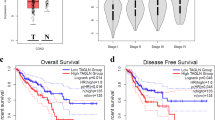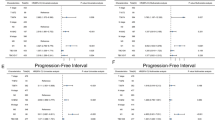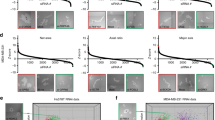Abstract
We have previously performed an unbiased screen to identify genes whose expression is associated with the metastatic phenotype. Secondary screening of these genes using custom microarray chips identified ASAP1, a multi-domain adaptor protein with ADP-ribosylation factor-GAP activity, as being potentially involved in tumor progression. Here, we show that at least three different splice forms of ASAP1 are upregulated in rodent tumor models in a manner that correlates with metastatic potential. In human cancers, we found that ASAP1 expression is strongly upregulated in a variety of tumors in comparison with normal tissue and that this expression correlates with poor metastasis-free survival and prognosis in colorectal cancer patients. Using loss and gain of function approaches, we were able to show that ASAP1 promotes metastasis formation in vivo and stimulates tumor cell motility, invasiveness, and adhesiveness in vitro. Furthermore, we show that ASAP1 interacts with the metastasis-promoting protein h-prune and stimulates its phosphodiesterase activity. In addition, ASAP1 binds to the SH3 domains of several proteins, including SLK with which it co-immunoprecipitates. These data support the notion that ASAP1 can contribute to the dissemination of a variety of tumor types and represent a potential target for cancer therapy.
This is a preview of subscription content, access via your institution
Access options
Subscribe to this journal
Receive 50 print issues and online access
$259.00 per year
only $5.18 per issue
Buy this article
- Purchase on Springer Link
- Instant access to full article PDF
Prices may be subject to local taxes which are calculated during checkout







Similar content being viewed by others
Accession codes
References
Andreev J, Simon JP, Sabatini DD, Kam J, Plowman G, Randazzo PA et al. (1999). Identification of a new Pyk2 target protein with Arf-GAP activity. Mol Cell Biol 19: 2338–2350.
Bharti S, Inoue H, Bharti K, Hirsch DS, Nie Z, Yoon HY et al. (2007). Src-dependent phosphorylation of ASAP1 regulates podosomes. Mol Cell Biol 27: 8271–8283.
Brown MT, Andrade J, Radhakrishna H, Donaldson JG, Cooper JA, Randazzo PA . (1998). ASAP1, a phospholipid-dependent arf GTPase-activating protein that associates with and is phosphorylated by Src. Mol Cell Biol 18: 7038–7051.
Buffart TE, Coffa J, Hermsen MA, Carvalho B, van der Sijp JR, Ylstra B et al. (2005). DNA copy number changes at 8q11-24 in metastasized colorectal cancer. Cell Oncol 27: 57–65.
Cougoule C, Carreno S, Castandet J, Labrousse A, Astarie-Dequeker C, Poincloux R et al. (2005). Activation of the lysosome-associated p61Hck isoform triggers the biogenesis of podosomes. Traffic 6: 682–694.
D'Angelo A, Garzia L, Andre A, Carotenuto P, Aglio V, Guardiola O et al. (2004). Prune cAMP phosphodiesterase binds nm23-H1 and promotes cancer metastasis. Cancer Cell 5: 137–149.
Ehlers JP, Worley L, Onken MD, Harbour JW . (2005). DDEF1 is located in an amplified region of chromosome 8q and is overexpressed in uveal melanoma. Clin Cancer Res 11: 3609–3613.
Fort P, Marty L, Piechaczyk M, el Sabrouty S, Dani C, Jeanteur P et al. (1985). Various rat adult tissues express only one major mRNA species from the glyceraldehyde-3-phosphate-dehydrogenase multigenic family. Nucleic Acids Res 13: 1431–1442.
Frame MC . (2004). Newest findings on the oldest oncogene; how activated src does it. J Cell Sci 117: 989–998.
Furman C, Short SM, Subramanian RR, Zetter BR, Roberts TM . (2002). DEF-1/ASAP1 is a GTPase-activating protein (GAP) for ARF1 that enhances cell motility through a GAP-dependent mechanism. J Biol Chem 277: 7962–7969.
Harlow E, Lane D . (1988). Antibodies: A Laboratory Manual. Cold Spring Harbor Press: Cold Spring Harbor.
Hashimoto S, Hirose M, Hashimoto A, Morishige M, Yamada A, Hosaka H et al. (2006). Targeting AMAP1 and cortactin binding bearing an atypical src homology 3/proline interface for prevention of breast cancer invasion and metastasis. Proc Natl Acad Sci USA 103: 7036–7041.
Hofmann M, Fieber C, Assmann V, Gottlicher M, Sleeman J, Plug R et al. (1998). Identification of IHABP, a 95 kDa intracellular hyaluronate binding protein. J Cell Sci 111 (Part 12): 1673–1684.
Isaacs JT, Isaacs WB, Feitz WF, Scheres J . (1986). Establishment and characterization of seven Dunning rat prostatic cancer cell lines and their use in developing methods for predicting metastatic abilities of prostatic cancers. Prostate 9: 261–281.
Jackson TR, Kearns BG, Theibert AB . (2000). Cytohesins and centaurins: mediators of PI 3-kinase-regulated Arf signaling. Trends Biochem Sci 25: 489–495.
Kowanetz K, Husnjak K, Holler D, Kowanetz M, Soubeyran P, Hirsch D et al. (2004). CIN85 associates with multiple effectors controlling intracellular trafficking of epidermal growth factor receptors. Mol Biol Cell 15: 3155–3166.
Kruljac-Letunic A, Moelleken J, Kallin A, Wieland F, Blaukat A . (2003). The tyrosine kinase Pyk2 regulates Arf1 activity by phosphorylation and inhibition of the Arf-GTPase-activating protein ASAP1. J Biol Chem 278: 29560–29570.
Lin D, Watahiki A, Bayani J, Zhang F, Liu L, Ling V et al. (2008). ASAP1, a gene at 8q24, is associated with prostate cancer metastasis. Cancer Res 68: 4352–4359.
Liu Y, Loijens JC, Martin KH, Karginov AV, Parsons JT . (2002). The association of ASAP1, an ADP ribosylation factor-GTPase activating protein, with focal adhesion kinase contributes to the process of focal adhesion assembly. Mol Biol Cell 13: 2147–2156.
Liu Y, Yerushalmi GM, Grigera PR, Parsons JT . (2005). Mislocalization or reduced expression of Arf GTPase-activating protein ASAP1 inhibits cell spreading and migration by influencing Arf1 GTPase cycling. J Biol Chem 280: 8884–8892.
Marino N, Zollo M . (2007). Understanding h-prune biology in the fight against cancer. Clin Exp Metastasis 24: 637–645.
Mengwasser J, Piau A, Schlag P, Sleeman JP . (2004). Differential immunization identifies PHB1/PHB2 as blood-borne tumor antigens. Oncogene 23: 7430–7435.
Nam JM, Onodera Y, Mazaki Y, Miyoshi H, Hashimoto S, Sabe H . (2007). CIN85, a Cbl-interacting protein, is a component of AMAP1-mediated breast cancer invasion machinery. EMBO J 26: 647–656.
Nestl A, Von Stein OD, Zatloukal K, Thies WG, Herrlich P, Hofmann M et al. (2001). Gene expression patterns associated with the metastatic phenotype in rodent and human tumors. Cancer Res 61: 1569–1577.
Nie Z, Hirsch DS, Luo R, Jian X, Stauffer S, Cremesti A et al. (2006). A BAR domain in the N terminus of the Arf GAP ASAP1 affects membrane structure and trafficking of epidermal growth factor receptor. Curr Biol 16: 130–139.
Niebuhr K, Lingnau A, Frank R, Wehland J . (1998). Rapid procedures for preparing monoclonal antibodies and identifying their epitopes. In: Celis J (ed). Cell Biology: A Laboratory Handbook, 2nd edn. Academic Prress: San Diego, pp 398–403.
Oda A, Wada I, Miura K, Okawa K, Kadoya T, Kato T et al. (2003). CrkL directs ASAP1 to peripheral focal adhesions. J Biol Chem 278: 6456–6460.
Onodera Y, Hashimoto S, Hashimoto A, Morishige M, Mazaki Y, Yamada A et al. (2005). Expression of AMAP1, an ArfGAP, provides novel targets to inhibit breast cancer invasive activities. EMBO J 24: 963–973.
Oshiro T, Koyama S, Sugiyama S, Kondo A, Onodera Y, Asahara T et al. (2002). Interaction of POB1, a downstream molecule of small G protein Ral, with PAG2, a paxillin-binding protein, is involved in cell migration. J Biol Chem 277: 38618–38626.
Palacios F, Schweitzer JK, Boshans RL, D'Souza-Schorey C . (2002). ARF6-GTP recruits Nm23-H1 to facilitate dynamin-mediated endocytosis during adherens junctions disassembly. Nat Cell Biol 4: 929–936.
Randazzo PA, Andrade J, Miura K, Brown MT, Long YQ, Stauffer S et al. (2000). The Arf GTPase-activating protein ASAP1 regulates the actin cytoskeleton. Proc Natl Acad Sci USA 97: 4011–4016.
Randazzo PA, Hirsch DS . (2004). Arf GAPs: multifunctional proteins that regulate membrane traffic and actin remodelling. Cell Signal 16: 401–413.
Sabe H, Hashimoto S, Morishige M, Ogawa E, Hashimoto A, Nam JM et al. (2009). The EGFR-GEP100-Arf6-AMAP1 signaling pathway specific to breast cancer invasion and metastasis. Traffic 10: 982–993.
Stein U, Jurchott K, Schlafke M, Hohenberger P . (2002). Expression of multidrug resistance genes MVP, MDR1, and MRP1 determined sequentially before, during, and after hyperthermic isolated limb perfusion of soft tissue sarcoma and melanoma patients. J Clin Oncol 20: 3282–3292.
Wagner S, Flood TA, O'Reilly P, Hume K, Sabourin LA . (2002). Association of the Ste20-like kinase (SLK) with the microtubule. Role in Rac1-mediated regulation of actin dynamics during cell adhesion and spreading. J Biol Chem 277: 37685–37692.
Webb BA, Eves R, Crawley SW, Zhou S, Cote GP, Mak AS . (2005). PAK1 induces podosome formation in A7r5 vascular smooth muscle cells in a PAK-interacting exchange factor-dependent manner. Am J Physiol Cell Physiol 289: C898–C907.
Zhou S, Webb BA, Eves R, Mak AS . (2006). Effects of tyrosine phosphorylation of cortactin on podosome formation in A7r5 vascular smooth muscle cells. Am J Physiol Cell Physiol 290: C463–C471.
Acknowledgements
This work was supported by grants to JPS and US from the BMBF NGFN2 CancerNet Program, to JPS from the European Union (FP6 STREP project BRECOSM, contract no. LSHC-CT-2004-503224), to MZ from AIRC 2007–2010 and to JPS and MZ from the Association for International Cancer Research (AICR, grant no. 08-0015). We thank Norma Howells and Selma Huber for animal care and Paul Randazzo, Craig Furman, and Margaret Frame for providing expression contructs. The contribution of Franziska Arlt Pia Hermann and Markus Niederstrasser is also gratefully acknowledged.
Author information
Authors and Affiliations
Corresponding author
Ethics declarations
Competing interests
The authors declare no conflict of interest.
Additional information
Supplementary Information accompanies the paper on the Oncogene website
Supplementary information
Rights and permissions
About this article
Cite this article
Müller, T., Stein, U., Poletti, A. et al. ASAP1 promotes tumor cell motility and invasiveness, stimulates metastasis formation in vivo, and correlates with poor survival in colorectal cancer patients. Oncogene 29, 2393–2403 (2010). https://doi.org/10.1038/onc.2010.6
Received:
Revised:
Accepted:
Published:
Issue Date:
DOI: https://doi.org/10.1038/onc.2010.6
Keywords
This article is cited by
-
ASAP1 activates the IQGAP1/CDC42 pathway to promote tumor progression and chemotherapy resistance in gastric cancer
Cell Death & Disease (2023)
-
Myr-Arf1 conformational flexibility at the membrane surface sheds light on the interactions with ArfGAP ASAP1
Nature Communications (2023)
-
SIEVE: joint inference of single-nucleotide variants and cell phylogeny from single-cell DNA sequencing data
Genome Biology (2022)
-
RAC1B modulates intestinal tumourigenesis via modulation of WNT and EGFR signalling pathways
Nature Communications (2021)
-
Integrative analysis of genomic amplification-dependent expression and loss-of-function screen identifies ASAP1 as a driver gene in triple-negative breast cancer progression
Oncogene (2020)



